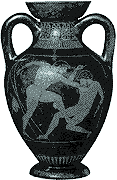Origin:
Boxing was added in 688
BC and is one of the oldest sports. Boxing was first mentioned in Homeric
poems, and was one of the games held in honor of the Patroclus. According to
mythology, Apollo was the inventor of boxing; he defeated and killed Phorbas, a
boxer who urged travelers through Delphi to compete with him. Apollo outboxed
Ares in Olympia.
The model boxing match in ancient mythology was the contest between
Polydeukes and Amykos, the king of the Bebrykes, who lived in Bithynia on the
Black Sea. The king would urge all strangers traveling through his country to
box with him and then kill them in the contest. Polydeukes was one of them, who
proved to be too tough of a competitor for the king, and he made the king swear
to leave travelers alone.
|
 |
|
|
Equipment:
Boxers wrapped
himantes, or straps of soft ox-hide around their hands to strengthen
their wrists and steady their fingers. Himantes were wrapped around the first
knuckles of the fingers, then ran diagonally across the palm onto the back of
the hand, leaving the thumb uncovered. Then they were tied around the wrist or
around the forearm.
The forms of these himantes, or thongs, evolved, and in order to make the
blows harsher, straps of harder leather were added around the knuckles of the
fingers.
Because these himantes were time-consuming to wrap, during the 4th century BC
boxers started to wear a kind of glove that was formed from ready-wound leather
straps. These gloves, called "oxeis himantes" (sharp thongs) which left
the fingertips free, had hard leather straps and an inner layer of wool to
protect the hand. The forearm was secured by leather straps as well.
The Roman invention of the caestus, a boxing glove reinforced with
iron and lead, transformed the Greek art of boxing into an inhuman and deadly
contest.
|
|
Rules of the Game
- Ancient boxing differed in many ways from modern boxing.
- The contest area is unknown.
- There was no time limit on the duration of the contest. Opponents fought
until one withdrew by raising one or two fingers to show that he admitted
defeat, or fell to the ground.
- Sometimes, if both contestants agreed, the referee would allow them time
to regain strength.
- Classification of the boxers by weights was unknown; instead, they fought
with whomever was chosen by lot.
- It seems that they favored effective blows to the head.
- The position of the boxer in relation to the sun was crucial. If one
managed to force his component into a position facing the sun, he would gain
an advantage in that his component would be blinded by the glare.
- When a contest continued for a long time, the opponents had the option of
klimax. During a
klimax, each man stood still and received a blow
from his opponent without making any attempt to avoid it.
The exact
rules of boxing are unknown, but we do know that the following were not allowed:
holds, blows to the genital organs, reinforcing the thongs with extra layers of
straps, and the use of pig-skin straps. The referees examined the thongs before
each contest.
Characteristics of a Good Boxer
According to Philostratos, the good boxer should have long and powerful
arms, strong shoulders, a high neck, and powerful and flexible wrists. Handicaps
are a thick shin (preventing agility) and a large stomach (prevents supple
movements). In addition, the boxer should possess persistence, patience,
endurance, great will-power, and strength.
Additional Information
Changes in the himantes (thongs) brought important changes in the technique
of the game. When the thongs were soft, boxing required agility, skill,
flexibility and a good technique, but when "sharp thongs" were introduced,
boxers paid more attention to defense, and the contest became heavier and
slower, with more emphasis on brute force rather than on skill. |
